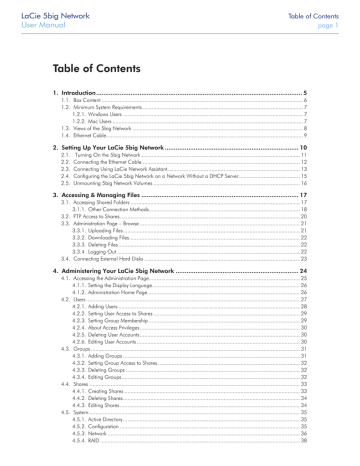- Computers & electronics
- Data storage
- Data storage devices
- NAS & storage servers
- LaCie
- 5big Network
- User manual
advertisement

LaCie 5big Network
User Manual
RAID and Disks
page 54
5.5. RAID 6
In RAID 6, data is striped across all disks (minimum of four) and a two parity blocks for each data block (p and q in
on the same stripe. If one physical disk fails, the data from the failed disk can be rebuilt onto a replacement disk. This Raid mode can support up to two disk failures with no data loss. RAID 6 provides for faster rebuilding of data from a failed disk.
Applications
RAID 6 provides data reliability with the addition of efficient rebuilding in the case of a failed drive. RAID 6 is therefore useful for people who need serious security with less of an emphasis on performance.
How RAID 6 Capacity Is Calculated
Each disk in a RAID 6 system should have the same capacity.
Storage capacity in a RAID 6 configuration is calculated by subtracting the number of drives by two and multiplying by the disk capacity, or
C = (n-2)*d where:
C = available capacity n = number of disks d = disk capacity
For example, in a RAID 6 array with five drives each with a capacity of 1000GB, the total capacity of the array would be 3000GB:
C = (5-2)*1000
RAID 6
A1
B1
C1
Dp
Disk 1
A2
B2
Cp
Dq
Disk 2
A3
Bp
Cq
D2
Disk 3
Ap
Bq
C3
D3
Disk 4
Aq
B3
C3
D3
Disk 5
Fig. 87
advertisement
* Your assessment is very important for improving the workof artificial intelligence, which forms the content of this project
Related manuals
advertisement
Table of contents
- 5 1. Introduction
- 6 1.1. Box Content
- 7 1.2. Minimum System Requirements
- 7 1.2.1. Windows Users
- 7 1.2.2. Mac Users
- 8 1.3. Views of the 5big Network
- 9 1.4. Ethernet Cable
- 10 2. Setting Up Your LaCie 5big Network
- 11 2.1. Turning On the 5big Network
- 12 2.2. Connecting the Ethernet Cable
- 13 2.3. Connecting Using LaCie Network Assistant
- 15 2.4. Configuring the LaCie 5big Network on a Network Without a DHCP Server
- 16 2.5. Unmounting 5big Network Volumes
- 17 3. Accessing & Managing Files
- 17 3.1. Accessing Shared Folders
- 18 3.1.1. Other Connection Methods
- 20 3.2. FTP Access to Shares
- 21 3.3. Administration Page – Browse
- 21 3.3.1. Uploading Files
- 22 3.3.2. Downloading Files
- 22 3.3.3. Deleting Files
- 22 3.3.4. Logging Out
- 23 3.4. Connecting External Hard Disks
- 24 4. Administering Your LaCie 5big Network
- 25 4.1. Accessing the Administration Page
- 26 4.1.1. Setting the Display Language
- 26 4.1.2. Administration Home Page
- 27 4.2. Users
- 28 4.2.1. Adding Users
- 29 4.2.2. Setting User Access to Shares
- 29 4.2.3. Setting Group Membership
- 30 4.2.4. About Access Privileges
- 30 4.2.5. Deleting User Accounts
- 30 4.2.6. Editing User Accounts
- 31 4.3. Groups
- 31 4.3.1. Adding Groups
- 32 4.3.2. Setting Group Access to Shares
- 32 4.3.3. Deleting Groups
- 32 4.3.4. Editing Groups
- 33 4.4. Shares
- 33 4.4.1. Creating Shares
- 34 4.4.2. Deleting Shares
- 34 4.4.3. Editing Shares
- 35 4.5. System
- 35 4.5.1. Active Directory
- 35 4.5.2. Configuration
- 36 4.5.3. Network
- 38 4.5.4. RAID
- 39 4.5.5. Disks
- 41 4.5.6. Status
- 41 4.5.7. Maintenance
- 44 4.5.8. System Log
- 45 4.5.9. Wake on LAN (WOL)
- 46 4.6. Download
- 47 4.7. Backup
- 48 4.8. Browse
- 48 4.9. Import (Snapshot)
- 49 4.10. Multimedia
- 50 5. RAID and Disks
- 50 5.1. Changing the RAID Level
- 51 5.2. RAID
- 52 5.3. RAID
- 53 5.4. RAID 5+Spare
- 54 5.5. RAID
- 55 5.6. RAID
- 56 5.7. Installing a New Disk
- 57 6. LED Indicators
- 58 7. Email Notification Triggers
- 59 8. Troubleshooting
- 61 9. Contacting Customer Support
- 62 8.1. LaCie Technical Support Contacts
- 63 10. Warranty Information